By Leen Randell
Updated: Jul 03, 2024
10 Best Herbal Tinctures For Itchy Skin
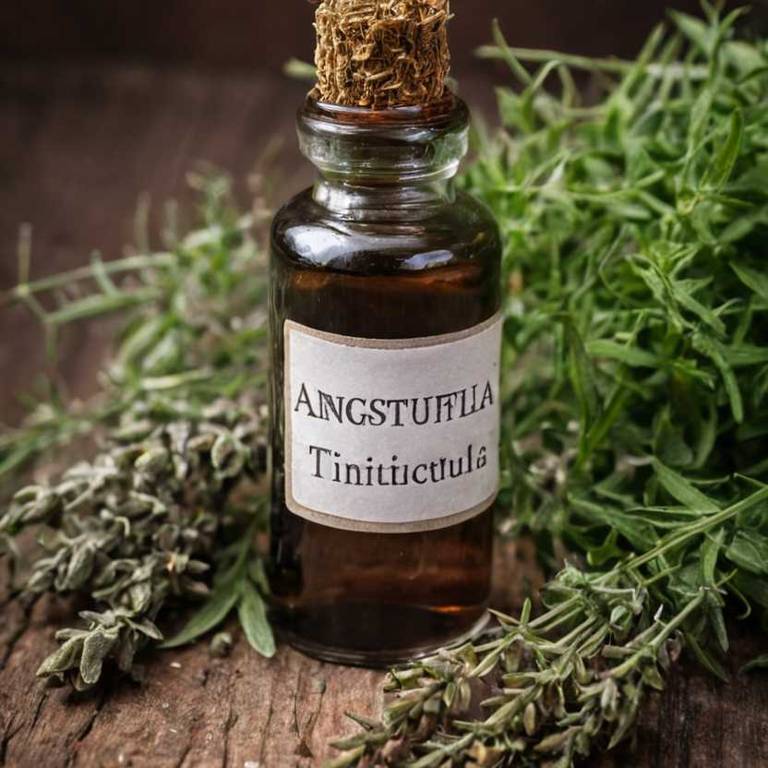
Herbal tinctures for itchy skin are liquid extracts made from plants, herbs, and spices that have anti-inflammatory and soothing properties.
These tinctures help to calm and relieve itchy skin by reducing inflammation, itching, and scratching, providing instant relief and comfort. For example, oatmeal tincture has been shown to soothe itchy skin caused by eczema, while tea tree oil tincture can help with fungal infections like ringworm.
By using these herbal tinctures, people suffering from itchy skin can finally find relief and enjoy a better quality of life, free from the constant discomfort and stress that comes with itchy skin.
The following article describes in detail the most important tinctures for itchy skin, including medicinal properties, parts of herbs to use, and recipes for preparations.
- 1. Calendula officinalis
- 2. Aloe vera
- 3. Urtica dioica
- 4. Echinacea purpurea
- 5. Althaea officinalis
- 6. Symphytum officinale
- 7. Tilia platyphyllos
- 8. Hypericum perforatum
- 9. Glycyrrhiza glabra
- 10. Taraxacum officinale
- What is the best combination of herbal tinctures to use for itchy skin?
- What ailments similar to itchy skin are treated with herbal tinctures?
1. Calendula officinalis
Pot marigold tinctures helps with itchy skin because of its potent anti-inflammatory and antiseptic properties.
The tannins and flavonoids present in pot marigold work together to reduce inflammation, soothe irritated skin, and calm the itching sensation. Additionally, pot marigold's antimicrobial properties help to prevent infections that can exacerbate itchiness.
As a result, using pot marigold tinctures topically or taking it orally can provide rapid relief from itchy skin, making it an effective natural remedy for eczema, psoriasis, and other skin conditions characterized by itching and inflammation.
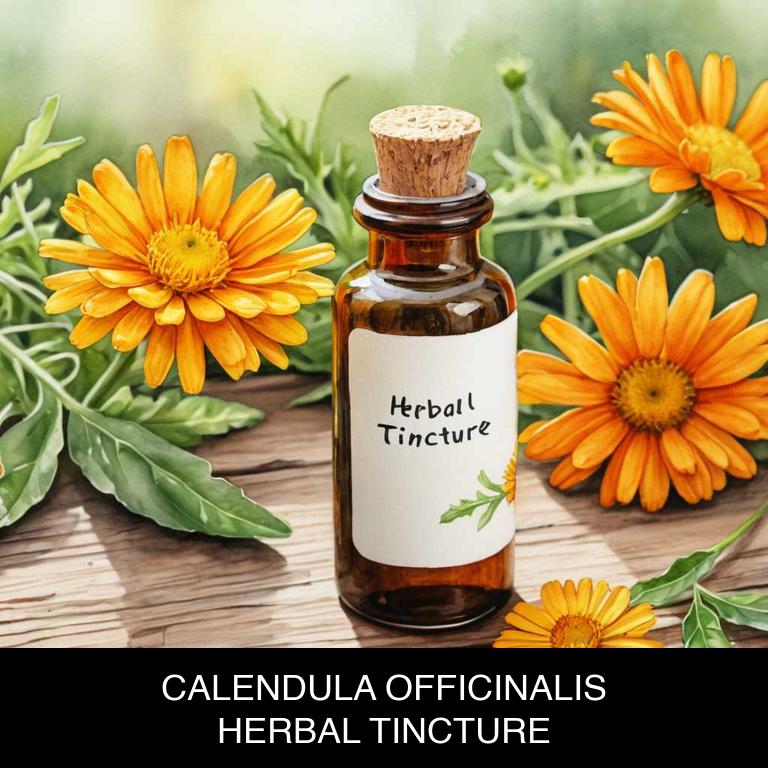
Medicinal Constituents
The list below shows the primary medicinal constituents in Calendula officinalis tinctures that help with itchy skin.
- Triterpenoids: These compounds have anti-inflammatory and soothing properties, which help reduce itching and inflammation associated with skin conditions.
- Flavonoids: As a potent antihistamine and anti-inflammatory agent, quercetin helps alleviate itching and discomfort caused by allergic reactions and skin irritation.
- Sesquiterpene lactones: These compounds exhibit anti-inflammatory and immunomodulatory effects, which help to reduce itching and inflammation by regulating the immune response and promoting wound healing.
Parts Used
The list below shows the primary parts of pot marigold used to make tinctures for itchy skin.
- Flowers: They are the most commonly used part of Calendula officinalis for tinctures due to their high concentration of anti-inflammatory and antiseptic compounds that soothe itchy skin.
- Leaves: The leaves are also used to make tinctures due to their ability to reduce inflammation and promote wound healing, which can help alleviate itchy skin conditions.
- Stems: The stems of Calendula officinalis contain anti-inflammatory and antimicrobial compounds that can help soothe and calm itchy skin, making them a viable option for tinctures.
Quick Recipe
The following recipe gives a procedure to make a basic pot marigold for itchy skin.
- Harvest 100g of fresh calendula officinalis flowers at peak bloom to ensure optimal potency.
- Dry the flowers in a warm place for 7-10 days to preserve their medicinal properties.
- Combine the dried flowers with 500ml of 80% ethanol in a clean glass jar.
- Store the mixture in a cool dark place for 2-4 weeks, shaking the jar daily.
- Strain the liquid through a cheesecloth or coffee filter into a clean glass bottle.
2. Aloe vera
Aloe tinctures helps with itchy skin because of its anti-inflammatory and soothing properties, which calm irritated skin and reduce itching sensations.
The aloe vera gel contains compounds like aloin and barbaloin that have been shown to inhibit histamine release, thereby reducing inflammation and alleviating itching.
Additionally, the tincture's antioxidant properties help to protect the skin from further damage, promoting healthy skin barrier function and relieving discomfort associated with itchy skin conditions such as eczema, psoriasis, and dermatitis.
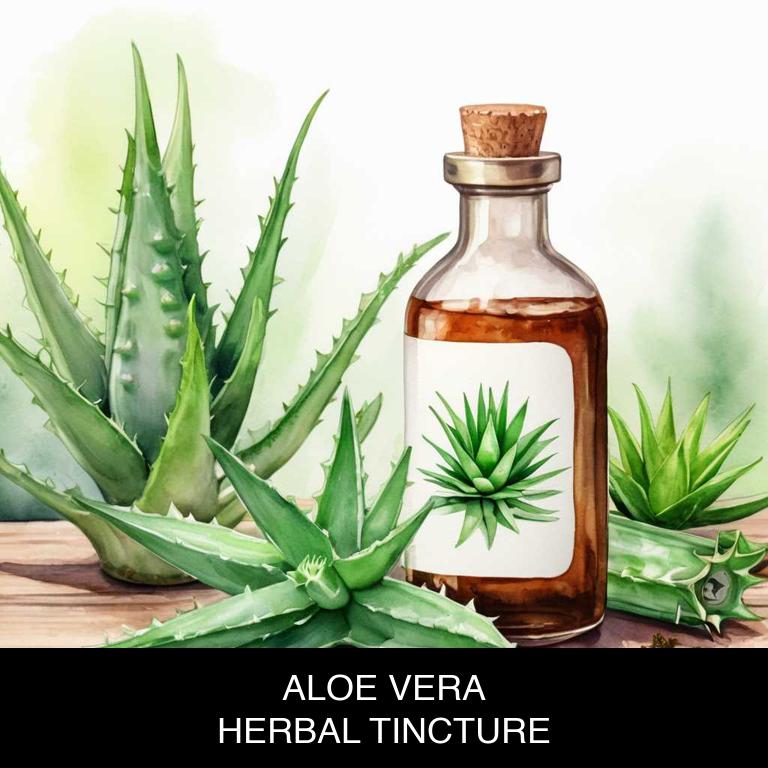
Medicinal Constituents
The list below shows the primary medicinal constituents in Aloe vera tinctures that help with itchy skin.
- Aloe-emodin: Aloe-emodin, a anthraquinone compound, has anti-inflammatory and antipruritic properties, which help to reduce itching and inflammation of the skin.
- Aloin: Aloin, a glycoside compound, acts as a natural antiseptic and anti-inflammatory agent, helping to soothe and calm itchy skin while preventing infections.
- Vitamins and minerals: Aloe vera tinctures are rich in vitamins and minerals, such as vitamin E and zinc, which have antioxidant and anti-inflammatory properties that help to reduce skin irritation and itching.
Parts Used
The list below shows the primary parts of aloe used to make tinctures for itchy skin.
- Leaves: The leaves are the most commonly used part of Aloe vera for tinctures due to their high concentration of anti-inflammatory compounds and soothing properties.
- Stems: The stems of Aloe vera are rich in vitamins, minerals, and amino acids that help to calm and soothe itchy skin, making them a popular choice for tincture production.
- Roots: The roots of Aloe vera are valued for their antioxidant and anti-inflammatory properties, which help to reduce inflammation and itching associated with skin irritations.
Quick Recipe
The following recipe gives a procedure to make a basic aloe for itchy skin.
- Gather fresh aloe vera leaves and clean them thoroughly with distilled water.
- Chop the aloe vera leaves into small pieces and measure out 500 grams.
- Combine the chopped aloe vera with 1500 milliliters of 95% ethanol in a clean glass jar.
- Store the mixture in a cool dark place and allow it to steep for 2 to 3 weeks.
- Strain the liquid through a cheesecloth and discard the solids then bottle the tincture.
3. Urtica dioica
Stinging nettle tinctures helps with itchy skin because of its anti-inflammatory and antihistamine properties.
The herbal extract contains compounds like histamine and serotonin, which work to reduce inflammation and soothe itchy sensations. Additionally, nettle's natural antiseptic and antimicrobial properties help to calm irritated skin, reducing redness and itching caused by allergic reactions or environmental factors.
By taking a standardized tincture, individuals can experience relief from bothersome itchiness and enjoy smoother, more comfortable skin.
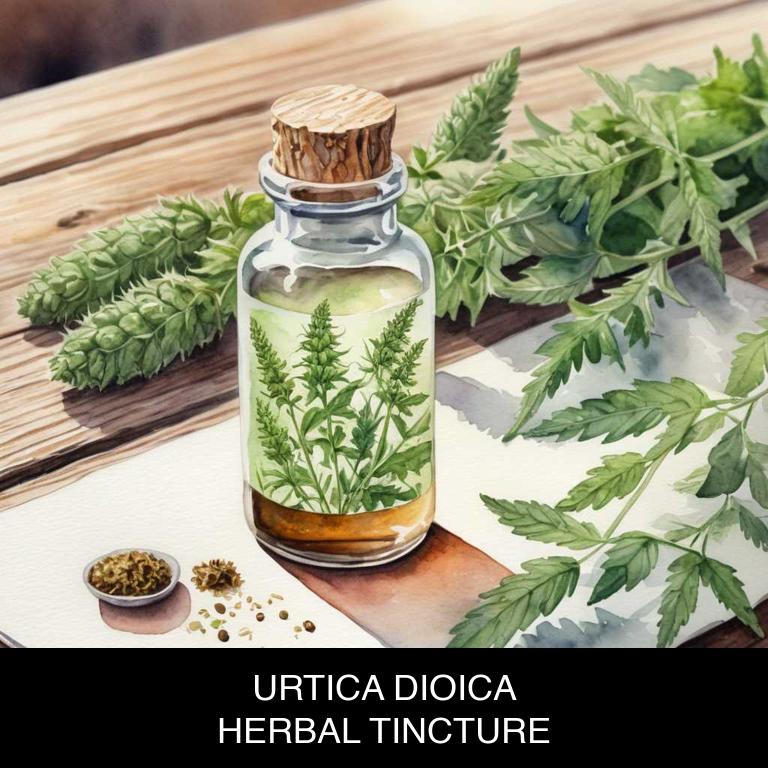
Medicinal Constituents
The list below shows the primary medicinal constituents in Urtica dioica tinctures that help with itchy skin.
- Stachydrine: A quaternary ammonium alkaloid that helps reduce inflammation and itching associated with itchy skin conditions by inhibiting histamine release and modulating the immune response.
- Alantolactone: A sesquiterpene lactone that has anti-inflammatory and antihistamine properties, which help to alleviate itchy skin by reducing inflammation and suppressing the release of histamine, a key mediator of itching.
- Aloe-emodin: A phenolic compound that exhibits anti-inflammatory and antipruritic (itch-relieving) properties, helping to soothe and calm itchy skin by reducing inflammation and modulating the immune response.
Parts Used
The list below shows the primary parts of stinging nettle used to make tinctures for itchy skin.
- Leaves: Urtica dioica leaves are used because they contain a high concentration of histamine-releasing compounds that help relieve itching and inflammation.
- Stems: Urtica dioica stems are used because they contain similar compounds to the leaves, which help to reduce itching and inflammation associated with skin conditions.
- Roots: Urtica dioica roots are used because they have anti-inflammatory and antioxidant properties, which help to soothe and calm itchy skin.
Quick Recipe
The following recipe gives a procedure to make a basic stinging nettle for itchy skin.
- Harvest urtica dioica leaves and stems when the plant is in full growth to ensure optimal potency.
- Chop the harvested urtica dioica parts into small pieces to increase their surface area for extraction.
- Steep one part of urtica dioica in two parts of a 80-proof spirit for four to six weeks in a sealed container.
- Strain the liquid mixture through a cheesecloth or a coffee filter to remove the plant material.
- Store the resulting tincture in a dark glass bottle with a tight-fitting lid to preserve its potency.
4. Echinacea purpurea
Purple coneflower tinctures helps with itchy skin because of its anti-inflammatory and antioxidant properties.
The herb's active compounds, such as triterpenoids and phenolic acids, work to soothe and calm the skin, reducing redness and inflammation caused by itchiness. Additionally, purple coneflower's antimicrobial properties help to prevent bacterial overgrowth, which can exacerbate itching conditions like eczema and dermatitis.
By using an herbal tincture made from purple coneflower, individuals may experience a significant reduction in itchy skin symptoms, leading to improved comfort and overall well-being.
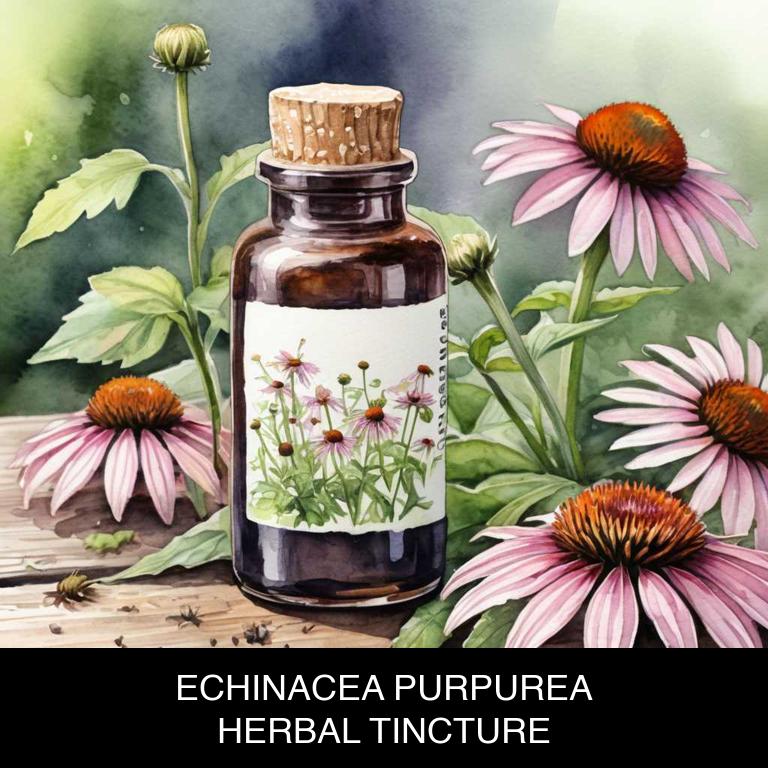
Medicinal Constituents
The list below shows the primary medicinal constituents in Echinacea purpurea tinctures that help with itchy skin.
- Isoquinoline alkaloids: These compounds, particularly echinatin and echinacoside, have anti-inflammatory properties that may help reduce itching and inflammation in the skin.
- Phenolic acids: Specifically, caftaric acid and caffeic acid in Echinacea purpurea have antioxidant and anti-inflammatory effects, which can help soothe itchy skin and reduce the severity of skin conditions.
- Polysaccharides: The polysaccharides present in Echinacea purpurea, such as arabinogalactan, may stimulate the immune system and have anti-inflammatory properties, which can help alleviate itchy skin caused by allergic reactions or skin conditions.
Parts Used
The list below shows the primary parts of purple coneflower used to make tinctures for itchy skin.
- Roots: Echinacea roots are used due to their high concentration of alkaloids and phenolic compounds, which have anti-inflammatory and antipruritic properties.
- Leaves: Echinacea leaves are used because they contain flavonoids and phenolic acids, which have been shown to have anti-inflammatory and antioxidant effects, helping to soothe itchy skin.
- Flowers: Echinacea flowers are used due to their high content of flavonoids, including quercetin, which has anti-inflammatory and antihistamine properties that can help relieve itchy skin.
Quick Recipe
The following recipe gives a procedure to make a basic purple coneflower for itchy skin.
- Harvest 1 pound of echinacea purpurea roots and flowers when they are in full bloom in late summer.
- Dry the roots and flowers in a warm place for 2 weeks to reduce moisture content.
- Use a ratio of 1 part dried herb to 2 parts vodka in a clean glass jar to prepare the tincture.
- Steep the mixture for 2 to 6 weeks in a cool dark place to allow for proper extraction.
- Strain the tincture through a cheesecloth or coffee filter and bottle it in dark glass containers.
5. Althaea officinalis
Marshmallow tinctures helps with itchy skin because of its soothing and anti-inflammatory properties.
The herb's mucilage, a thick, gel-like substance, coats the skin, providing a protective barrier that calms irritated skin and reduces itching and inflammation. Additionally, marshmallow root contains flavonoids, which have antioxidant properties that help to reduce oxidative stress and promote healthy skin cells.
As a result, herbal marshmallow tinctures can provide fast and effective relief for itchy skin, making it an excellent natural remedy for various skin conditions.
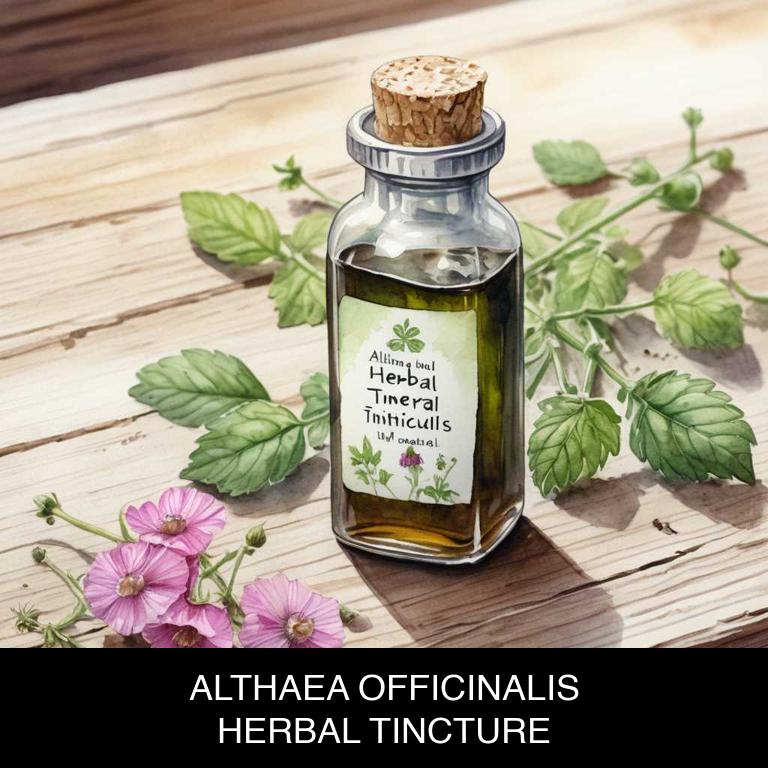
Medicinal Constituents
The list below shows the primary medicinal constituents in Althaea officinalis tinctures that help with itchy skin.
- Polysaccharides: These complex carbohydrates help soothe and calm irritated skin, reducing inflammation and itching associated with skin conditions.
- Althaea officinalis flavonoids: These flavonoids, including kaempferol and quercetin, possess anti-inflammatory properties that help alleviate itching and discomfort caused by skin irritations.
- Mucilages: These thick, gel-like compounds help form a protective barrier on the skin, reducing dryness and itching, while also exhibiting anti-inflammatory and soothing effects.
Parts Used
The list below shows the primary parts of marshmallow used to make tinctures for itchy skin.
- Roots: They contain mucilages, which help soothe and calm itchy skin.
- Leaves: They have anti-inflammatory and antiseptic properties that can help reduce itching and inflammation.
- Barks: They contain compounds that have anti-itch and anti-inflammatory effects, which can provide relief from itchy skin.
Quick Recipe
The following recipe gives a procedure to make a basic marshmallow for itchy skin.
- Gather 1 part dried althaea officinalis root and 2 parts vodka in a clean glass container.
- Combine the herb and vodka in the container and seal it tightly with a lid.
- Steep the mixture in a cool dark place for 2-6 weeks to allow extraction.
- Strain the liquid through a cheesecloth or coffee filter into another clean container.
- Label and store the final tincture in a dark glass bottle with a dropper lid.
6. Symphytum officinale
Comfrey tinctures helps with itchy skin because of its anti-inflammatory and antimicrobial properties.
The herb contains allantoin, a powerful soothing agent that calms irritated skin, reducing redness and itching. Additionally, comfrey's antifungal and antibacterial compounds help to combat infections that can contribute to itchiness.
When applied topically as a tincture, comfrey's natural ingredients work together to provide fast and effective relief from itchy skin, leaving it feeling calm, cool, and comfortable.
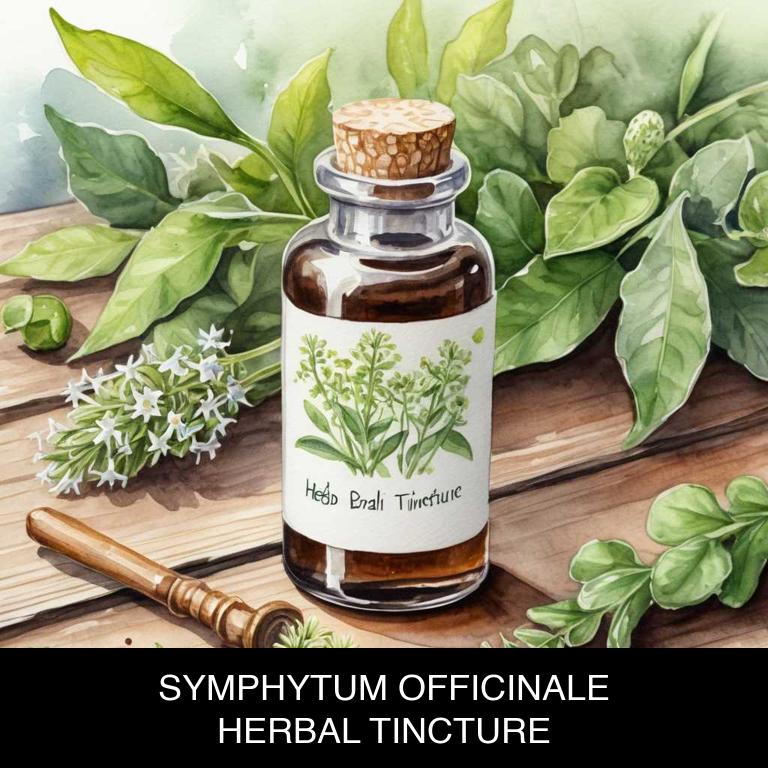
Medicinal Constituents
The list below shows the primary medicinal constituents in Symphytum officinale tinctures that help with itchy skin.
- Allantoin: Allantoin helps with itchy skin by reducing inflammation and promoting wound healing, thereby alleviating the discomfort associated with itchy skin conditions.
- Phenolic acids: Phenolic acids in Comfrey help with itchy skin by exhibiting antioxidant and anti-inflammatory properties, which can soothe and calm irritated skin.
- Saponins: Saponins in Comfrey help with itchy skin by exhibiting anti-inflammatory and soothing effects, which can help reduce the itching and discomfort associated with skin conditions.
Parts Used
The list below shows the primary parts of comfrey used to make tinctures for itchy skin.
- Leaves: They are the primary source used for tinctures due to their high concentration of compounds with anti-inflammatory and soothing properties.
- Roots: They are also commonly used as they contain a higher amount of glycosides, which help in alleviating itchy skin conditions.
- Buds: Buds of Symphytum officinale are sometimes used for tinctures, as they are believed to have a more potent effect on itchy skin conditions compared to other parts.
Quick Recipe
The following recipe gives a procedure to make a basic comfrey for itchy skin.
- Harvest 1 part of fresh roots and leaves of symphytum officinale in the morning after the dew has dried.
- Chop the harvested plant material into small pieces using a sharp knife to increase surface area.
- Combine the chopped plant material with 2 parts of 80% ethanol in a clean glass jar.
- Allow the mixture to macerate for 2 weeks in a cool dark place shaking the jar every day.
- Strain the liquid through a cheesecloth or a coffee filter into a clean glass bottle discarding the solids.
7. Tilia platyphyllos
Broad-leaved lime tinctures helps with itchy skin because of its anti-inflammatory and antihistamine properties.
The natural compounds present in the leaves, such as flavonoids and terpenes, help to soothe and calm irritated skin, reducing inflammation and alleviating itching. Additionally, the astringent properties of broad-leaved lime tinctures can help to tighten and shrink swollen skin tissue, providing quick relief from itchy skin conditions like eczema and dermatitis.
This natural remedy offers a gentle and effective way to alleviate itchiness and promote overall skin health.
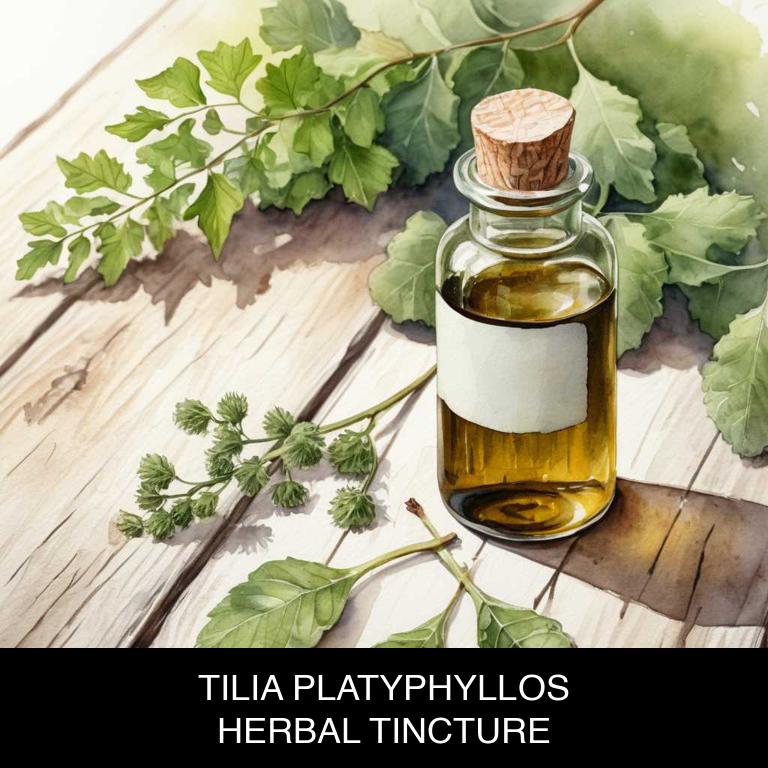
Medicinal Constituents
The list below shows the primary medicinal constituents in Tilia platyphyllos tinctures that help with itchy skin.
- Flavonoids: Flavonoids, specifically quercetin, help alleviate itchy skin by reducing inflammation and modulating the immune response.
- Terpenoids: The terpenoids present in Tilia platyphyllos have anti-inflammatory and soothing properties, which help calm and relieve itchy skin.
- Phenolic acids: Phenolic acids have antioxidant and anti-inflammatory effects, which help mitigate the underlying causes of itchy skin, such as oxidative stress and inflammation.
Parts Used
The list below shows the primary parts of broad-leaved lime used to make tinctures for itchy skin.
- Leaves: Tilia platyphyllos leaves are often used to make tinctures for itchy skin due to their anti-inflammatory properties.
- Buds: Tilia platyphyllos buds are used for their soothing effects on itchy skin, providing relief from irritation.
- Barks: Tilia platyphyllos barks are utilized in tinctures for their antiseptic and anti-inflammatory properties, helping to reduce itchiness and inflammation.
Quick Recipe
The following recipe gives a procedure to make a basic broad-leaved lime for itchy skin.
- Gather 100 grams of dried tilia platyphyllos flowers from a reputable supplier.
- Combine the dried flowers with 500 milliliters of 80 proof vodka in a clean glass jar.
- Store the mixture in a cool dark place for 2 to 6 weeks, shaking jar daily.
- Strain the liquid mixture through a cheesecloth or a coffee filter into a clean container.
- Discard the solids and store the tincture in a cool dark place for up to 2 years.
8. Hypericum perforatum
St John's Wort tinctures helps with itchy skin because of its anti-inflammatory and antihistamine properties.
The active compounds in the herb, such as hyperforin and hypericin, work to reduce inflammation and alleviate itching sensations. This can provide relief from conditions like eczema, psoriasis, and bug bites. Additionally, St John's Wort has been shown to modulate the immune system, which can help to reduce allergic reactions that contribute to itchy skin.
By addressing both underlying inflammation and immune response, St John's Wort tinctures offer a natural and effective approach to soothing itchy skin.
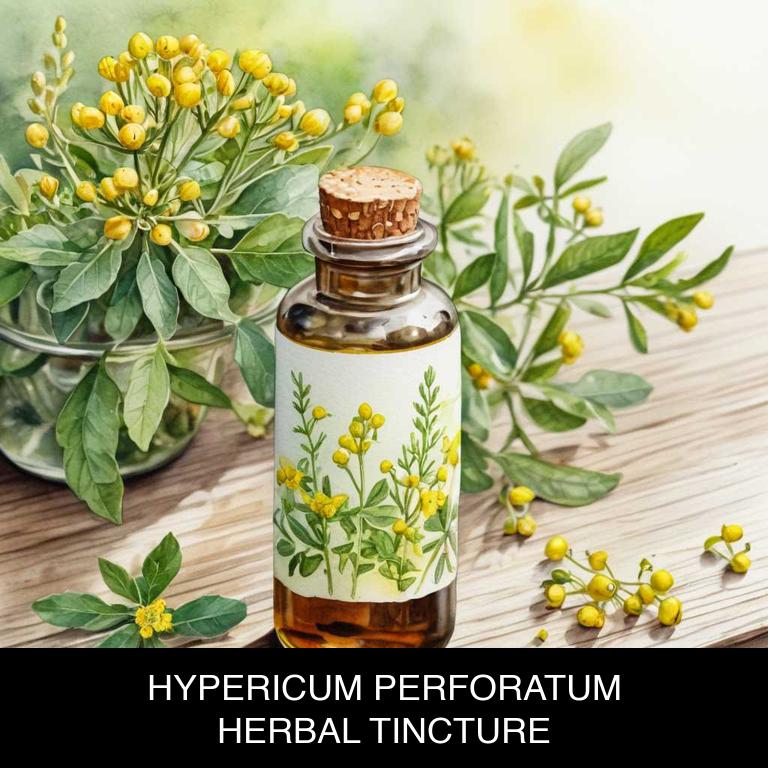
Medicinal Constituents
The list below shows the primary medicinal constituents in Hypericum perforatum tinctures that help with itchy skin.
- Hyperforin: Hyperforin is a phenolic compound that has anti-inflammatory and antihistaminic properties, helping to reduce itching and inflammation associated with skin conditions.
- N-feruloylserotonin: This compound has been shown to have anti-inflammatory and antipruritic (itch-reducing) effects, which contribute to the soothing properties of Hypericum perforatum for itchy skin.
- Flavonoids: Flavonoids in Hypericum perforatum have antioxidant, anti-inflammatory, and antihistaminic properties, which can help to reduce oxidative stress, inflammation, and itching associated with skin conditions.
Parts Used
The list below shows the primary parts of st john's wort used to make tinctures for itchy skin.
- Leaves: They are rich in flavonoids, which are known for their anti-inflammatory and antihistamine properties, making them effective in relieving itchy skin.
- Flowers: The flowers are abundant in naphthoquinones, particularly hyperforin and hypericin, which have potent anti-inflammatory and antiseptic properties that help soothe itchy skin.
- Stems: The stems of Hypericum perforatum contain bioflavonoids and phenolic acids, which exhibit antioxidant and anti-inflammatory properties, contributing to their effectiveness in treating itchy skin.
Quick Recipe
The following recipe gives a procedure to make a basic st john's wort for itchy skin.
- Harvest 20-30 grams of fresh hypericum perforatum flowers in the morning after the dew has dried.
- Chop the flowers into small pieces using a sharp knife to increase surface area.
- Combine the chopped flowers with 40-50 percent vodka by volume in a clean glass jar.
- Store the jar in a cool dark place for 2-6 weeks to allow for infusion.
- Strain the liquid through a cheesecloth or coffee filter into another clean glass bottle.
9. Glycyrrhiza glabra
Licorice tinctures helps with itchy skin because of its anti-inflammatory properties, which reduce redness and swelling.
The glycyrrhizin in licorice root also exhibits antihistaminic effects, blocking histamine release and alleviating itching sensations. Additionally, licorice has been shown to stimulate the production of cortisol, a hormone that helps regulate skin health and reduce inflammation.
By addressing these underlying causes of itchiness, herbal licorice tinctures can provide relief from itchy skin conditions such as eczema, dermatitis, and psoriasis.
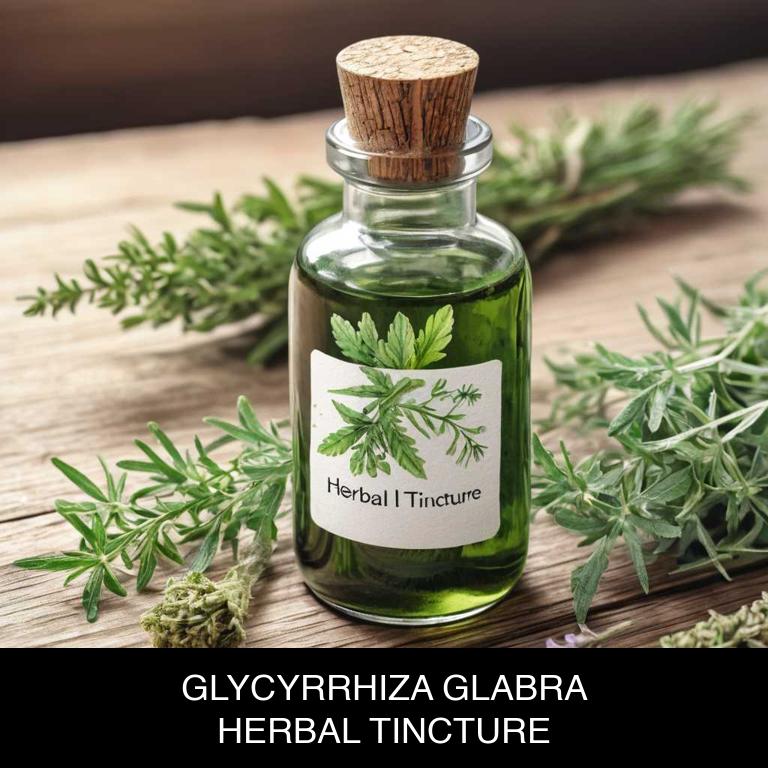
Medicinal Constituents
The list below shows the primary medicinal constituents in Glycyrrhiza glabra tinctures that help with itchy skin.
- Glycyrrhizin: A triterpenoid saponin that helps reduce inflammation and itching in the skin by inhibiting the production of pro-inflammatory enzymes and cytokines.
- Liquiritigenin: A flavanone that exhibits anti-inflammatory and antipruritic properties, helping to soothe and calm itchy skin.
- 18α-glycyrrhetinic acid: A triterpenoid acid that has potent anti-inflammatory and antipruritic effects, helping to reduce itching and inflammation in the skin.
Parts Used
The list below shows the primary parts of licorice used to make tinctures for itchy skin.
- Roots: They are the primary part used due to their high glycyrrhizin content, which is responsible for the anti-inflammatory and soothing properties that help alleviate itchy skin.
- Barks: The barks are another commonly used part, containing a similar composition to the roots, which helps in reducing inflammation and itching.
- Leaves: Although less commonly used compared to roots and barks, the leaves of Glycyrrhiza glabra are still utilized in some tinctures, offering a milder form of anti-inflammatory and soothing properties.
Quick Recipe
The following recipe gives a procedure to make a basic licorice for itchy skin.
- Harvest 1 part of dried roots of glycyrrhiza glabra, typically 1-2 kg, in the morning after the dew has dried.
- Chop the roots into smaller pieces, about 1-2 cm in size, to increase the surface area for extraction.
- Combine the chopped roots with 70% ethanol as a solvent, using a 1:5 ratio by weight, in a clean glass container.
- Steep the mixture in a cool, dark place for 2-3 weeks, shaking the container occasionally to enhance extraction.
- Strain the liquid through a cheesecloth or a coffee filter into a clean glass bottle, discard the solids.
10. Taraxacum officinale
Dandelion tinctures helps with itchy skin because of its anti-inflammatory and antipruritic properties.
The plant's bioactive compounds, such as taraxasterol and flavonoids, have been shown to soothe and calm irritated skin, reducing itching and scratching associated with conditions like eczema, psoriasis, and dermatitis. Additionally, dandelion tincture's antimicrobial activity may help combat underlying infections that can exacerbate itchy skin issues.
By addressing the root causes of itchiness, dandelion tincture provides natural relief from uncomfortable and distracting skin symptoms.
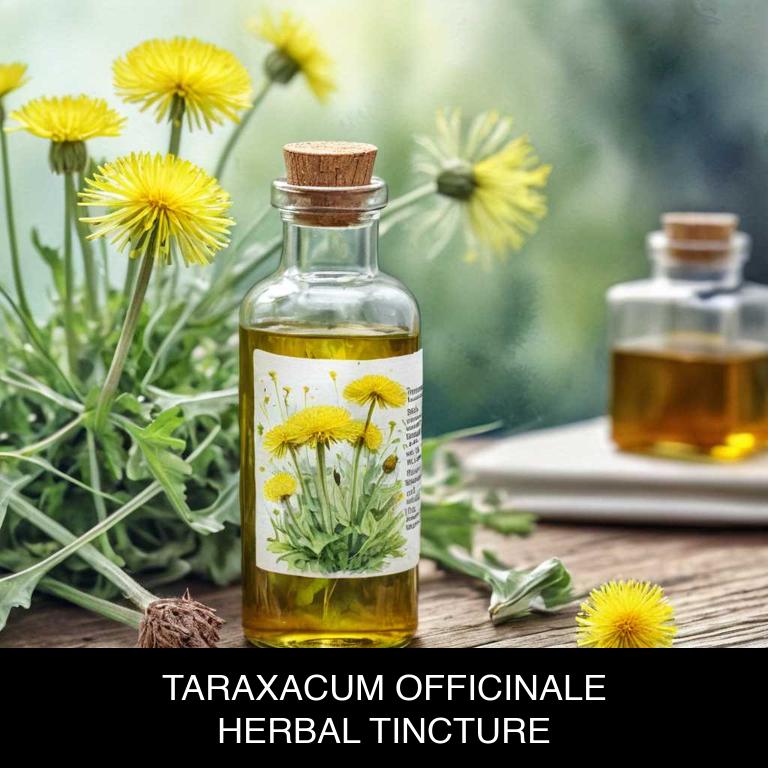
Medicinal Constituents
The list below shows the primary medicinal constituents in Taraxacum officinale tinctures that help with itchy skin.
- Taraxasterol: It has anti-inflammatory properties, which help to reduce itching and inflammation caused by skin irritations.
- Luteolin: As a flavonoid, it has potent anti-inflammatory and antioxidant effects that can soothe itchy skin and reduce the severity of allergic reactions.
- Kaempferol: Another flavonoid present in Taraxacum officinale, kaempferol has anti-inflammatory and antihistamine properties that can help alleviate itching and redness associated with skin conditions.
Parts Used
The list below shows the primary parts of dandelion used to make tinctures for itchy skin.
- Leaves: They are used due to their anti-inflammatory and antihistamine properties, which help soothe itchy skin.
- Roots: They contain taraxasterol, which has been shown to exhibit anti-inflammatory and antipruritic effects, reducing itchiness.
- Flowers: They are used for their antihistamine and anti-inflammatory properties, which help alleviate itchy skin and other allergic reactions.
Quick Recipe
The following recipe gives a procedure to make a basic dandelion for itchy skin.
- Harvest fresh taraxacum officinale roots and leaves in early morning to ensure optimal potency.
- Dry the harvested plant material in a warm place with good air circulation for 2 days.
- Combine 250 grams of dried taraxacum officinale with 750 milliliters of 95 percent ethanol in a glass jar.
- Steep the mixture for 2 weeks in a cool dark place with occasional shaking to facilitate extraction.
- Strain the liquid through a cheesecloth and discard the solids to obtain the final tincture.
What is the best combination of herbal tinctures to use for itchy skin?
The best combination of herbal tinctures that help with itchy skin is a blend of Calendula, Aloe Vera, and Tea Tree.
Calendula tincture soothes and calms irritated skin, while Aloe Vera helps to hydrate and moisturize, reducing inflammation. Tea Tree tincture, with its antifungal and antibacterial properties, fights off any underlying infections that may be causing the itch.
Together, these three tinctures create a powerful and natural remedy for itchy skin, promoting healing and comfort.
What ailments similar to itchy skin are treated with herbal tinctures?
Ailments similar to itchy skin that are treated with herbal tinctures are eczema, psoriasis, and dermatitis.
Herbal remedies such as calendula, chamomile, and aloe vera can soothe and calm irritated skin. Tinctures of burdock root, dandelion, and yellow dock can help reduce inflammation and itching associated with these conditions.
Additionally, tinctures of lavender and peppermint can provide relief from mild to moderate symptoms of skin irritation and itching.